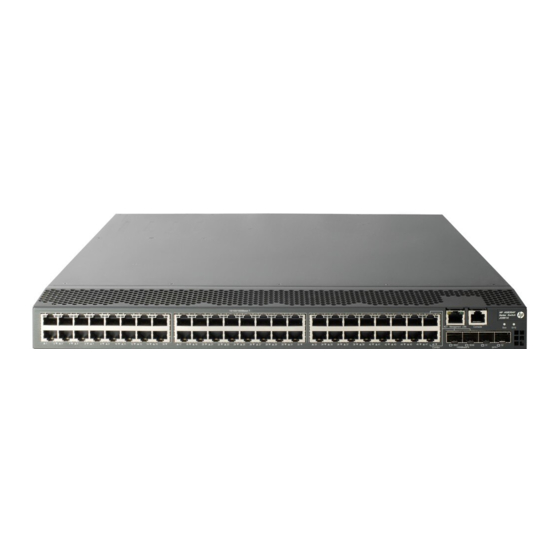
HP A5830 Series Ethernet Switch Manuals
Manuals and User Guides for HP A5830 Series Ethernet Switch. We have 6 HP A5830 Series Ethernet Switch manuals available for free PDF download: Configuration Manual, Command Reference Manual, Installation Manual
HP A5830 Series Configuration Manual (280 pages)
Security Switch
Table of Contents
-
-
-
-
-
-
-
VLAN Assignment105
-
ACL Assignment105
-
Guest VLAN105
-
-
-
-
-
Configuring PKI
155-
PKI Terms155
-
PKI Architecture156
-
PKI Applications157
-
PKI Operation157
-
-
-
SSH Operation176
-
-
Configuring SFTP
198
Advertisement
HP A5830 Series Command Reference Manual (249 pages)
Layer 2 - LAN Switching
Table of Contents
-
-
-
-
Group-Member35
-
MDI40
-
Speed Auto43
-
-
Mtu46
-
-
-
-
Default69
-
Description69
-
Shutdown91
-
-
-
Display Stp97
-
Display Stp Root115
-
Display Stp Tc116
-
Instance118
-
Region-Name119
-
Reset Stp119
-
Revision-Level120
-
Stp Compliance122
-
Stp Cost124
-
Stp Edged-Port125
-
Stp Enable126
-
Stp Ignored Vlan128
-
Stp Max-Hops129
-
Stp Mcheck130
-
Stp Mode131
-
Stp Port-Log135
-
Stp Priority136
-
Stp Root Primary137
-
Stp Timer Hello142
-
Stp Timer-Factor144
-
-
Default150
-
Description150
-
Display Vlan154
-
Ip Address157
-
Mtu158
-
Name158
-
Shutdown160
-
Vlan160
-
-
Display Port161
-
Port162
-
Port Access Vlan163
-
Port Hybrid Pvid164
-
Port Hybrid Vlan165
-
Port Link-Type167
-
Port Trunk Pvid169
-
-
-
Display Mac-Vlan170
-
Mac-Vlan Enable173
-
Vlan Precedence176
-
-
HP A5830 Series Configuration Manual (246 pages)
Layer 2 LAN Switching
Table of Contents
-
-
-
-
-
-
Using RSTP60
-
Using PVST60
-
Using MSTP60
-
-
-
Configuring VLAN
108 -
Configuring GVRP
141-
Using GVRP144
-
Advertisement
HP A5830 Series Configuration Manual (207 pages)
High Availability
Table of Contents
-
-
-
CFD Overview21
-
-
-
-
Background35
-
-
-
-
Background54
-
Rrppdus56
-
RRPP Timers57
-
-
-
-
VRRP Overview117
-
-
-
HP A5830 Series Configuration Manual (152 pages)
Brand: HP
|
Category: Network Router
|
Size: 1 MB
Table of Contents
HP A5830 Series Installation Manual (67 pages)
Table of Contents
-
Overview5
-
Fan Failure41
-
Documents43
-
Websites43
-
Conventions44
Advertisement





